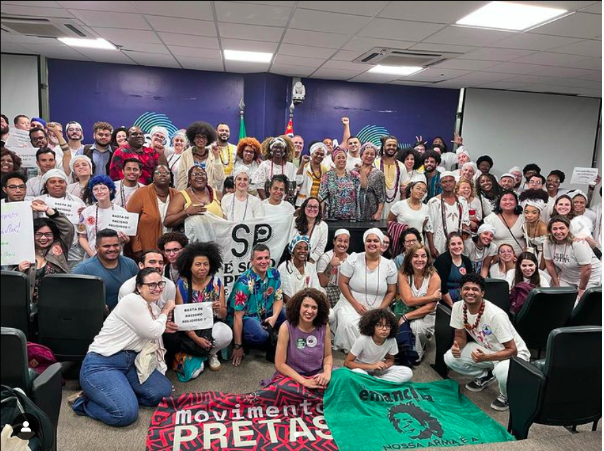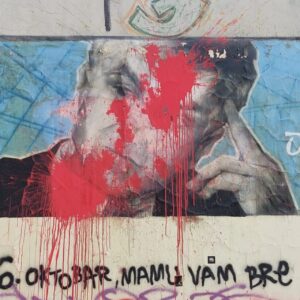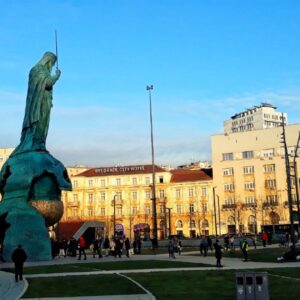Teaching contested histories in Brazil: strategies and struggles to diversify the historical landscape of São Paulo
By Vinícius Borges Garcia Fonseca •

Interview conducted by Vinícius Borges Garcia Fonseca on May 11, 2023.
DISCLAIMER: The following interview was conducted in Portuguese to allow the interviewee to express herself more naturally. Hence, aspects of the conversation have been shortened or clarified, but none of the original content or meaning was changed.
Interview with Ms. Ana Laura Oliveira, teacher and activist, conducted by Vinícius Borges Garcia Fonseca on May 11, 2023.
DISCLAIMER: The following interview was conducted in Portuguese to allow the interviewee to express herself more naturally. Hence, aspects of the conversation have been shortened or clarified, but none of the original content or meaning was changed.
The landscape of the state and city of São Paulo reveals an overwhelming number of historical sites, museums, and statues related to the Bandeiras event in Brazilian colonial history. The Bandeiras were expeditions carried out by Portuguese conquistadores during the sixteenth and seventeenth centuries, departing from what is now São Paulo’s state into the remote countryside of Brazil. Their primary objectives were to discover gold, silver, and diamond mines from which the Portuguese Crown could profit. For this reason, the Bandeirantes, the name given to the explorers conducting the Bandeiras, are considered to have generated a significant portion of the wealth accumulated by the state of São Paulo and were celebrated by various governments for their endeavours. Moreover, they are often regarded as responsible for connecting distant parts of Brazil and fostering a ‘common’ identity for the Brazilian people.
Nevertheless, contemporary scholars of Brazilian colonial history have described the character of the Bandeiras as exploitative, as the Bandeirantes enslaved and often killed Indigenous and African people during their activities. In this sense, critics argue that their efforts contributed to the reduction of Brazil’s countryside population, the decimation of Indigenous people, and the establishment of problematic socioeconomic relationships that have shaped the country’s history. Consequently, the Bandeirantes are disputed as negative historical references for the Brazilian population.
In this interview with Ms Ana Laura Oliveira, a grassroots educator and a member of a collective mandate in São Paulo’s state Legislative House, she discusses the work done by the Emancipa social movement to engage young people in critically thinking about their history, the importance of diversifying the historical landscape to include underrepresented social groups and the challenges of altering the Brazilian landscape to present what she regards as a ‘better set of messages for the country’s future.’
Did you have any experience or contact with the contestations of the Bandeirantes before becoming a Member of São Paulo’s state Parliament?
What I remember about the Bandeirantes at schools is that they were portrayed as the ‘Saviours of the Homeland.’ That is what they told us about their history. They arrived and helped civilise Brazil, and this was very good. So there were images in the textbooks portraying them as good people despite having guns in their hands, which I remember very emotively. So it was a bit of a contradiction. When I started going to places that made me question what our history is, I realised that our history is told from a completely different perspective. It is told from the view of the oppressor. Because those who were massacred, those who were oppressed, those who were murdered because of this civilising endeavour of the Bandeirantes…their story is not being told. So I remember the ‘Fora Cunha!’ demonstration, which was a national feminist demonstration in Brazil, as the first time I saw multiple women occupy the Bandeiras’ monument (Monumento às Bandeiras) to protest. That was in 2015 if I am not mistaken.
I remember it was the first time that I had seen that symbol. And then I realised that I would never understand how people looked at that monument and did not feel impacted, did not feel hurt. To see Black people pushing the Bandeirantes there, you know? It is extremely violent. And we found similar symbols in other places, such as the Borba Gato statue itself. These symbols hurt us a lot because when you start understanding our history, you realise they symbolise those who killed our own. So it is a very painful symbol. It is very hurtful to understand that our collective memory is tied to the oppressor’s narrative and not the narrative of those who effectively built Brazil.
How do you understand the importance of having monuments and references in the historical landscape of Brazil and São Paulo that represent the diversity of the city and country?
When talking about memory and history, what we choose to remember is what stays in people’s imagination. So if we think that what is remembered today through monuments and statues is related to murder and genocide, symbolising the negative things we have had in our history, it means that we are establishing a negative perspective for the future of society. If we transform this memory by remembering the real heroes, those who really built the country, the great leaders who resisted until the end, and all the people who sacrificed themselves and, in some way, are important to our history, especially for Black and Indigenous people, I think we can build a society that will actually reflect on these events. I think we need to stop honouring racists and Slavocrats. We need to stop and think about how we can build a less racist Brazil.
It is true that if we don’t remember what Nazism was, we might suffer from Nazism again. But it is one thing to remember what it was and have it told in history textbooks, and it is another thing to have it as a symbol in the middle of a public square celebrating it. If we want to celebrate important figures, we should celebrate our ancestors, our orixás, elders, shamans, and so on. Those who really have a different perspective on the future. If we change the narrative to say, ‘The Bandeirantes were great oppressors and murderers of Black and Indigenous people in Brazil,’ we start to tell the story the right way, and people will think, ‘We can’t do that kind of thing again, can we?’
What is it like fighting this battle for a more diverse historical landscape in São Paulo’s legislative houses?
I think it is a very difficult process because it requires a lot of articulation. Unfortunately, people are not convinced when you say that a monument is racist and that it hurts when you see it. You must have the power of political persuasion, and the people who are in the Legislative House need to have the political will to look at that monument and say, ‘Maybe it is not good for my constituents if I continue to defend racists.’ That’s how we have been convincing people, by saying, ‘Look, if you honour a racist, you are possibly a racist yourself.’ Today, the increased penalties for the crime of racism have helped a lot to raise awareness over the issue. That was fundamental.
At the same time, we realise that it is not an easy process to approve a Bill on cultural heritage. So, in São Paulo’s City Council, Bill 47/2021 [1] has stalled because if Councilwoman Luana (who is leading the discussion on the matter inside the Council) puts it on the agenda for voting, the Council will turn into chaos… the council members do not want to vote on it. They want to block it. The Bill should have gone to the second round of voting for a long time already. In the state’s House, there have already been several bills with the same perspective that have been blocked by the CCJ, the Constitution and Justice Committee.
It is a very difficult struggle to approve such bills in the Legislative Houses. To me, it can only work if there is a movement behind the proposal. If there are political organisations, if people are engaged in the debate. And then, by discussing cultural heritage, we open up the debate in society, promoting a dispute of the narrative of things, which is very important. So, when we take these issues to the media, or when we manage to develop activities, when we go to school spaces and present our project, we also dispute the narrative. This pressures the Members of Parliament and council members because it generates the question, ‘Why are you in favour of honouring racists? Why are you in favour of honouring slavery?’ Then, being under pressure might lead them to change their position. But it is still very difficult because, unfortunately, despite the defeat of the previous government of Jair Bolsonaro, we are still going through a very difficult political process. Various sectors, which are very well organised and strengthened, really want to erase our history and identity.
Have any of these projects related to Historical Culture and Heritage advanced during your journey in institutional politics?
In São Paulo’s state Legislative House, it is very difficult. Because it is a space that does not open for voting easily, it is only when the president of the House wishes it to be. The Bills are not processed in the same way as in the City Council. So, for us to put a project on the agenda, we need to have internal agreements within the House, so we can get the project up for a vote.. However, even if the bills are not approved, answers are being given to our movement so that we can think about moving forward. I believe in opportunities, and we must manage to approve Bill 47/2021 in São Paulo because it is the largest capital in Latin America. If we can set a precedent like this for Brazil, we can move forward with ‘Black and Indigenous Land’ (the name given to Bill 47/2021). For example, it has gone to some other cities– São Paulo and Rio de Janeiro. Together with Member of Parliament Sâmia Bonfim, we filed the ‘Black and Indigenous Land’ project at the federal level. And now, with this new political scenario of the current government, we have new possibilities. So our idea is to be able to suggest nominations for the Ministry of Human Rights, the Ministry of Racial Equality, and the Ministry of Indigenous Peoples so that we can move forward with the project at the national level. If we can organise for this project to have a place nationally, we can make progress in people’s awareness of the issue and education concerning contested histories.
Do you believe São Paulo’s city government is including Black and Indigenous people in the decision-making process?
This type of bill has been a historical demand of the Brazilian Black Movement. It has been articulated for a long time by the Black Movement and sectors of the Black Movement, from the vanguard to the grassroots. So, when we come up with a project like that, we attempt to make these connections to include the vanguard and the more peripheral movements, which are further away from the political centre. There is a need for an answer. From the moment we started putting together booklets and working with the local communities, we created the possibility for people to tell the stories of their neighbourhoods, their families, and those who built the spaces where they live. So, to a certain degree, the point of the project is for it to take root in the spaces. What we are doing is organising ideas together with people.
Councilwoman Luana and I went to several schools to talk about the ‘Black and Indigenous Land’ project. The schools have a huge turnout, and they are very important spaces. So, at the same time as it is a historical demand from the vanguard, the more recent social movements are aware of the need to promote this debate; we know the need to root this process because it is not an automatic process. It is not just because we are saying in the newspaper, ‘Ah! We’re going to defeat the Slavocrats!’ that people will think, ‘We’re going to defeat them!’ That is not how it works.
Shortly after Bill 47/2021 was presented, São Paulo’s mayorship decided to build five statues in homage to important Black personalities of the city. Was your movement invited to debate the creation of these statues?
No, we just heard the news. The Polis Institute was a group doing some more elaborate research into this. This group was invited together with some other groups that the state’s Historical Department was involved with, which are groups that don’t have a political side and are not allied to parties. So what did the city council do? It took these people, held a debate with them, and decided to create these statues and monuments in homage to Black personalities. There was an internal conflict between the Black movements because many of the historical movements had not been involved in this either. I remember coming into a meeting where there was a heated discussion and saying, ‘Guys, the issue is not between us. It is with the city council that they did it without consulting us. Without telling everyone.’ So, we realised that the city council was working to divide us at all times. We know they intended to give us an answer, but we needed to use the opportunity to show the importance of having political organisation among us. If not, they would continue to make unilateral decisions to ‘seal the deal,’ giving superfluous answers to our demands.
This situation served to expose some sectors that fight ‘Black and Indigenous Land’ (Bill 47/2021) at all costs because they are linked to the Brazilian nationalistic movement, to São Paulo’s patriotic nationalism, that defends the Bandeirantes, that defends the families that descend from them. So these groups exist in São Paulo and are in charge. They once organised a joint effort and filled Councilwoman Luana’s email inbox, saying that it was absurd to remove the statues of the Bandeirantes of Borba Gato… So we know that they are organised, we know that they are a class, but it’s very difficult to say who they are and what their names are. I could easily say that Dória (the former governor of São Paulo) is one of those patriots from São Paulo. I could say that Tarcísio de Freitas (the current governor) is one of those, too, since he received a statue of the Bandeirantes and clapped his hands with great joy. However, it is difficult for us to say that categorically. Unfortunately, it is like I have been saying all along: people relativise pain, people cannot understand others’ pain.
What is the work you believe needs to be done to foster an anti-racist memory, so to speak, that can critically interpret the Monument to the Bandeiras or the figure of Borba Gato?
I think the main thing that drives people is to say you must tell your story, your family’s story. So, talking about myself, I didn’t know my great-grandmother’s name. Many people like me don’t… I don’t know where my family’s name came from, I don’t know why I don’t have any possessions, and I don’t know why my family doesn’t own a house. When you show this to people, people identify with it too. So, ‘Well… my town has no monuments, no history, nothing.’ But, for example, questioning, ‘Why does this street have that name? Why does this school have that name? Why does that hospital have that name?’ is important. When you start questioning these things, citizens realise that there are people who decide these names, and some spaces are deciding who receives homage and how. By doing this, people start to question themselves and to debate. So, it is based on their feelings regarding their own story.
Does the Emancipa social movement also fulfil this function of promoting critical history thinking?
Emancipa has been involved in popular education for some time. We have almost eighty centres throughout Brazil. It stimulates a debate to say that our young people, Black and peripheral, our women, and so on, have to have access to university spaces. The university needs to be democratised so that the knowledge we have there can also be given back to the periphery. So the debate we’re having within Emancipa has been going on for a long time. We discuss the importance of going into those spaces where we are not wanted, occupying those spaces, and bringing the knowledge back. So we advance this critical thinking daily. We have built one of our centres, the Emancipa Axé, which has the objective of promoting the debate in traditional territories, in the Afro-Brazilian religious centres (terreiros de candomblé) because if there is one place today that tells the story of our people, it’s the terreiros. So it is a center in which we have been working to strengthen the awareness of Afro-Brazilian history. It has been twenty years since the Afro-Brazilian Education Law was passed in schools and in Indigenous schools too, but so far, this law has not been implemented. So how do we press for this law to be implemented? We need pressure from all sides, especially in the education sector, which I think is the basis of everything.
How should this anti-racist education be taught? Have you had direct contact with this issue?
What we have as a major complaint is that we have a very bad curriculum, even more so with this new High School. So, we already have a bad curriculum, and on top of that, the teachers are not trained to give lessons on African history, which is very basic. People are not prepared to give lessons on African history. At the beginning of the Lula government, in 2003-2004, there was a project called ‘Mojubá’. This project intended to make Afro-Brazilian education enter the school’s curriculum. I remember my mother talking about it a lot since she is a state teacher and a Candomblecist, and I remember her saying that the school management did not seek anyone experienced in the culture to do this training and be able to give it back to the students. And that the people selected to do this training were evangelical white women. Then you can guess, ‘Did they pass on this training to the students? No!’ So, for example, people like my mother, an engaged teacher who is aware of the racial issues in Brazil, ended up preparing to teach African History on their own. But there is no training, there is no curriculum, there’s no investment in it.
So we know that the Law on Afro-Brazilian Education is a reality far from consolidated in public schools. Moreover, I was monitoring the curriculum of the supplementary courses that people normally do to pass university, which are private, and other more expensive preparatory courses, and they are providing anti-racist education. They say they have a new teaching content that they are using. They are debating anti-racist education in private schools. And then, I can’t help but think that there is an emerging classist movement that wants to study racism to test how to respond to the protests and contestations. Without public investment, it means the government does not want the poorer classes to organise themselves and understand who they are in society. It is very difficult. So the people who can afford to pay are studying and becoming racially literate to prepare for what’s to come and maintain control of the decision-making process.
I believe this underscores the necessity of granting autonomy, agency, and the power of control to Black, Indigenous, and peripheral communities within this process. From what I can observe, the social and political mobilisation initiative lies with you. However, the decision-making process remains obstructed; individuals are still impeding progress, dictating the extent of advancement. These individuals are not the leaders of this movement advocating for a contested consciousness. It is intriguing to acknowledge that merely studying other cultures or alternative sources does not necessarily lead to an emancipatory education or an emancipatory cultural heritage. I envisage that you face a daily undertaking you have been diligently pursuing over the past few years.
About the author
Vinícius Fonseca recently obtained his master’s degree in Applied History at Erasmus University Rotterdam. His research covers Historical Culture and Heritage, with a particular interest in how history shapes current-day public policies. His master’s research explored the racial aspects of the Portuguese colonisation of Brazil, how that is reflected in the Historical Culture displayed in public spaces, and how racialised groups have engaged in contesting such heritage today. He intends to continue his studies on Historical Culture and Heritage policy, and social mobilisation, as a PhD candidate, a researcher, or a policy analyst. Vinícius was a research intern during the 1st semester of 2023. Since then, he has been collaborating with EuroClio and, more specifically, the Contested Histories project.
End Notes
[1] Bill 47/2021 determines the substitution of historical markers, statues, plaques, and any other homages to figures involved in the defence of the slavery regime. They shall be substituted by markers related to historical Black and Indigenous personalities.




